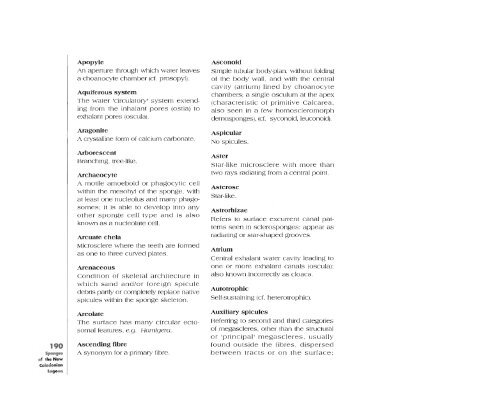Sponges of the New Caledonian lagoon - IRD
Sponges of the New Caledonian lagoon - IRD
Sponges of the New Caledonian lagoon - IRD
Create successful ePaper yourself
Turn your PDF publications into a flip-book with our unique Google optimized e-Paper software.
190<br />
<strong>Sponges</strong><br />
<strong>of</strong> <strong>the</strong> <strong>New</strong><br />
<strong>Caledonian</strong><br />
Lagoon<br />
Apopyle<br />
An aperture through which water leaves<br />
a choanocyte chamber (cL prosopyl).<br />
Aquiferous system<br />
The water 'circulatory' system extending<br />
from <strong>the</strong> inhalant pores (ostia) to<br />
exhalant pores (oscula).<br />
Aragonite<br />
A crystalline form <strong>of</strong> calcium carbonate.<br />
Arborescent<br />
Branching, tree-like.<br />
Archaeocyte<br />
A motile amoeboid or phagocytic cell<br />
within <strong>the</strong> mesohyl <strong>of</strong> <strong>the</strong> sponge, with<br />
at least one nucleolus and many phagosomes;<br />
it is able to develop into any<br />
o<strong>the</strong>r sponge cell type and is also<br />
known as a nucleolate cell.<br />
Arcuate chela<br />
Microsclere where <strong>the</strong> teeth are formed<br />
as one to three curved plates.<br />
Arenaceous<br />
Condition <strong>of</strong> skeletal architecture in<br />
which sand and/or foreign spicule<br />
debris partly or completely replace native<br />
spicules within <strong>the</strong> sponge skeleton.<br />
Areolate<br />
The surface has many circular ectosomal<br />
features, e.g. Hamigera.<br />
Ascending fibre<br />
A synonym for a primary fibre.<br />
Asconoid<br />
Simple tubular body-plan, without folding<br />
<strong>of</strong> <strong>the</strong> body wall, and with <strong>the</strong> central<br />
cavity (atrium) lined by choanocyte<br />
chambers: a single osculum at <strong>the</strong> apex<br />
(characteristic <strong>of</strong> primitive Calcarea,<br />
also seen in a few homoscleromorph<br />
demosponges), (et. syconoid, leuconoid).<br />
Aspicular<br />
No spicules.<br />
Aster<br />
Star-like microsclere with more than<br />
two rays radiating from a central point.<br />
Asterose<br />
Star-like.<br />
Astrorhizae<br />
Refers to surface excurrent canal pattems<br />
seen in sclerosponges: appear as<br />
radiating or star-shaped grooves.<br />
Atrium<br />
Central exhalant water cavity leading to<br />
one or more exhalant canals (oscula):<br />
also known incorrectly as cloaca.<br />
Autotrophic<br />
Self-sustaining (cL heterotrophic).<br />
Auxiliary spicules<br />
Referring to second and third categories<br />
<strong>of</strong> megascleres, o<strong>the</strong>r than <strong>the</strong> structural<br />
or 'principal' megascleres, usually<br />
found outside <strong>the</strong> fibres, dispersed<br />
between tracts or on <strong>the</strong> surface:

















